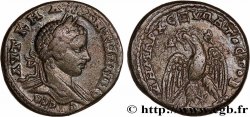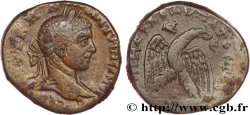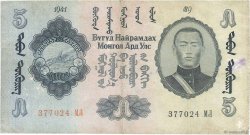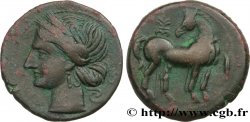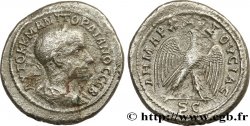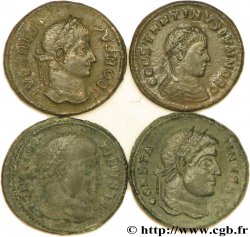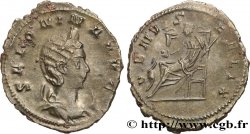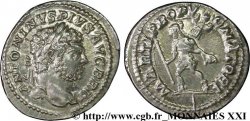E-auction 578-527896 - bpv_659119 - ELAGABALUS Tétradrachme syro-phénicien
You must signin and be an approved bidder to bid, LOGIN TO BID. Accounts are subject to approval and the approval process takes place within 48 hours. Do not wait until the day a sale closes to register. Clicking on « bid » constitutes acceptance of the terms of use of cgb.fr private e-auctions.
Bids must be placed in whole Euro amounts only. The sale will start closing at the time stated on the item description; any bids received at the site after the closing time will not be executed. Transmission times may vary and bids could be rejected if you wait until the last second. For further information ckeck the E-auctions F.A.Q.
NO BUYER'S FEE.
NO BUYER'S FEE.
| Estimate : | 70 € |
| Price : | 29 € |
| Maximum bid : | 31 € |
| End of the sale : | 13 May 2024 15:03:00 |
| bidders : | 7 bidders |
Type : Tétradrachme syro-phénicien
Date: 218-220
Mint name / Town : Antioche, Syrie, Séleucie et Piérie
Metal : billon
Diameter : 23,5 mm
Orientation dies : 12 h.
Weight : 13,85 g.
Rarity : R2
Coments on the condition:
Monnaie bien centrée, avec un revers bien détaillé. Patine grise, tachée au droit
Catalogue references :
Obverse
Obverse description : Elagabal tête laurée à droite, les rubans de la couronne de lauriers flottant derrière la tête, un reste de draperie devant et derrière le buste.
Obverse legend : AUT K M A ... ANTwNEINOS SEB
Obverse translation : Empereur César Marc Aurèle Antonin Auguste.
Reverse
Reverse description : Aigle aux ailes en ovales verticaux debout à droite sur une ligne de terre, les ailes déployées, la tête et queue à gauche, tenant une couronne feuillée de laurier dans son bec, une étoile à huit rais entre les pattes.
Reverse legend : DHMARC EX UPATOSTOB / .D. - .E.
Reverse translation : (Puissance tribunitienne, consul pour la deuxième fois).
Commentary
Les graveurs de revers variés classés entre le Prieur 273 et le 278 essayent de montrer la variété des graveurs de revers pour Elagabal. En ce qui concerne le Prieur 276, il semble d’un graveur unique pour le revers, qui pourrait rappeler certains revers d’Arados sous Caracalla. Ces graveurs ont manifestement réalisé quelques coins de revers, un seul parfois, comme le Prieur 274, alors que le droit est d’un graveur connu.
Les exemplaires de cette série sont conformes à l’idée d’un regroupement des graveurs à Antioche : plusieurs coins de droit se retrouvent avec d’autres graveurs de revers. On peut donc penser que tous ces graveurs travaillaient dans le même atelier, sauf, bien entendu, si l’on arrive un jour à prouver que les coins de droit voyageaient. De tels coins voyageurs ont été repérés dans la région pour des bronzes à cette période : là encore, une analyse des liaisons de coins serait essentielle à la compréhension du monnayage.
Les émissions d’Elagabal se classent par référence à leur graveur de revers, quand celui-ci peut être rapproché d’une émission précédente identifiée pour une ville, par le style plus généralement quand ce n’est pas le cas. On trouve une trentaine de graveurs de revers et moins d’une dizaine de graveurs de droit.
La question de savoir si les ateliers de Caracalla, encore en production sous Macrin, furent conservés ou si tous les graveurs furent regroupés à Antioche n’est pas tranchée, faute d’une analyse des liaisons de coins. On pense néanmoins que ce fut le cas, ne serait-ce que par la présence systématique du Delta Eta dans le champ du revers.
Tous les tétradrachmes officiels d’Elagabal portent la date du deuxième consulat, le hiatus entre Caracalla et le nouvel empereur étant considéré comme le premier consulat de celui-ci. À en juger par certaines émissions, les frappes se terminent certainement, dans une dégénerescence complète de l’aloi et du style, vers 220, en tous cas avant le troisième consulat.
On note que les sigma sont gravés en C.
Dans la base TSP maintenue par Michel Prieur, sept exemplaires sont maintenant répertoriés.
The varied reverse engravers classified between Prior 273 and 278 try to show the variety of reverse engravers for Elagabal. Regarding Prior 276, it appears to be from a single engraver for the reverse, which could recall certain reverses of Arados under Caracalla. These engravers obviously made a few reverse dies, sometimes just one, like Prieur 274, while the right is by a known engraver.
The examples of this series conform to the idea of a grouping of engravers in Antioch: several obverse dies are found with other reverse engravers. We can therefore think that all these engravers worked in the same workshop, unless, of course, we can one day prove that the obverse dies traveled. Such traveling dies were spotted in the region for bronzes during this period: here again, an analysis of the die connections would be essential to understanding the coinage..
Elagabal's issues are classified by reference to their reverse engraver, when this can be compared to a previous issue identified for a city, by style more generally when this is not the case. There are around thirty reverse engravers and less than ten legal engravers..
The question of whether the workshops of Caracalla, still in production under Macrinus, were preserved or if all the engravers were grouped together in Antioch is not resolved, due to the lack of an analysis of the die connections.. We nevertheless believe that this was the case, if only by the systematic presence of Delta Eta in the reverse field..
All official tetradrachms of Elagabalus bear the date of the second consulship, the hiatus between Caracalla and the new emperor being considered the latter's first consulship. Judging by certain issues, the strikes certainly end, in a complete degeneration of the law and style, around 220, in any case before the third consulate.
We note that the sigma are engraved in C.
In the TSP database maintained by Michel Prieur, seven examples are now listed
Les exemplaires de cette série sont conformes à l’idée d’un regroupement des graveurs à Antioche : plusieurs coins de droit se retrouvent avec d’autres graveurs de revers. On peut donc penser que tous ces graveurs travaillaient dans le même atelier, sauf, bien entendu, si l’on arrive un jour à prouver que les coins de droit voyageaient. De tels coins voyageurs ont été repérés dans la région pour des bronzes à cette période : là encore, une analyse des liaisons de coins serait essentielle à la compréhension du monnayage.
Les émissions d’Elagabal se classent par référence à leur graveur de revers, quand celui-ci peut être rapproché d’une émission précédente identifiée pour une ville, par le style plus généralement quand ce n’est pas le cas. On trouve une trentaine de graveurs de revers et moins d’une dizaine de graveurs de droit.
La question de savoir si les ateliers de Caracalla, encore en production sous Macrin, furent conservés ou si tous les graveurs furent regroupés à Antioche n’est pas tranchée, faute d’une analyse des liaisons de coins. On pense néanmoins que ce fut le cas, ne serait-ce que par la présence systématique du Delta Eta dans le champ du revers.
Tous les tétradrachmes officiels d’Elagabal portent la date du deuxième consulat, le hiatus entre Caracalla et le nouvel empereur étant considéré comme le premier consulat de celui-ci. À en juger par certaines émissions, les frappes se terminent certainement, dans une dégénerescence complète de l’aloi et du style, vers 220, en tous cas avant le troisième consulat.
On note que les sigma sont gravés en C.
Dans la base TSP maintenue par Michel Prieur, sept exemplaires sont maintenant répertoriés.
The varied reverse engravers classified between Prior 273 and 278 try to show the variety of reverse engravers for Elagabal. Regarding Prior 276, it appears to be from a single engraver for the reverse, which could recall certain reverses of Arados under Caracalla. These engravers obviously made a few reverse dies, sometimes just one, like Prieur 274, while the right is by a known engraver.
The examples of this series conform to the idea of a grouping of engravers in Antioch: several obverse dies are found with other reverse engravers. We can therefore think that all these engravers worked in the same workshop, unless, of course, we can one day prove that the obverse dies traveled. Such traveling dies were spotted in the region for bronzes during this period: here again, an analysis of the die connections would be essential to understanding the coinage..
Elagabal's issues are classified by reference to their reverse engraver, when this can be compared to a previous issue identified for a city, by style more generally when this is not the case. There are around thirty reverse engravers and less than ten legal engravers..
The question of whether the workshops of Caracalla, still in production under Macrinus, were preserved or if all the engravers were grouped together in Antioch is not resolved, due to the lack of an analysis of the die connections.. We nevertheless believe that this was the case, if only by the systematic presence of Delta Eta in the reverse field..
All official tetradrachms of Elagabalus bear the date of the second consulship, the hiatus between Caracalla and the new emperor being considered the latter's first consulship. Judging by certain issues, the strikes certainly end, in a complete degeneration of the law and style, around 220, in any case before the third consulate.
We note that the sigma are engraved in C.
In the TSP database maintained by Michel Prieur, seven examples are now listed








 Report a mistake
Report a mistake Print the page
Print the page Share my selection
Share my selection Ask a question
Ask a question Consign / sell
Consign / sell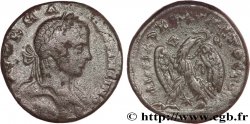
 Full data
Full data